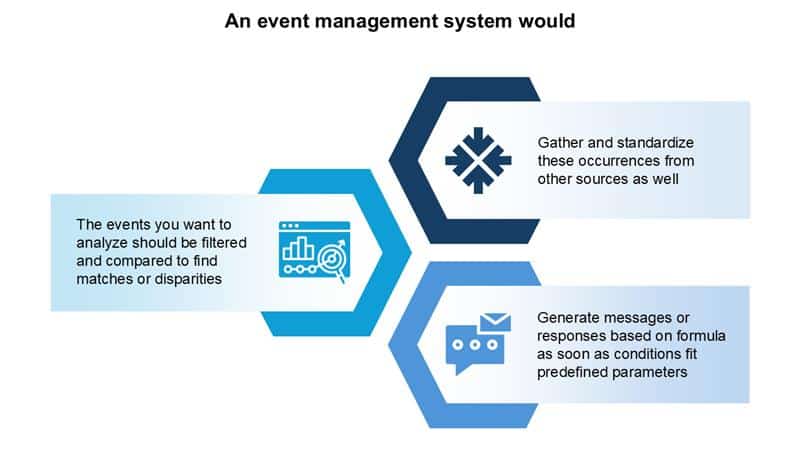Incident vs. Event Management: Choosing the Right Strategy for Your IT Environment
Incident vs. Event Management: Choosing the Right Strategy for Your IT Environment

A new and promising trend in IT management is the so-called Artificial Intelligence for IT Operation or AIOps. Hence, by using Machine Learning and Big Data Analytics, AIOps platforms assist organizations in resolving complex IT challenges. AIOps tools are able to analyze large volumes of data collected from different areas and then provide insights that are helpful in anticipating organizational performance.
It is also worth stating that one of the areas in which AIOps is gaining the most popularity at the moment is the sphere of incident and event management. By leveraging these two concepts, IT professionals can optimally deploy AIOps to improve their daily functioning and service provision.
What is incident management – example
Service disruption can be defined as the act of handling an event that interrupts or degrades the delivery of IT services. The first objective is to return to normal methods of service delivery as soon as possible, with as small a disruption as possible to the business.
Example: Imagine an e-commerce website experiencing a sudden spike in page load times, causing customers to abandon their shopping carts. This performance degradation is an incident that requires immediate attention.
The incident management process would involve:
- Detection and logging of the issue
- Categorization and prioritization based on impact and urgency
- Investigation and diagnosis of the root cause
- Resolution and recovery actions
- Incident closure and documentation
In this scenario, an AIOps-powered incident management system might automatically detect the anomaly, correlate it with other relevant data points (e.g., server metrics, network traffic), and suggest potential causes or solutions to the IT team.

What is event management – example
In its simplest terms, event management is the act of identifying, assessing, and controlling occurrences within an IT environment. An event is any action that can occur in a system or a network; this can range from user login, the end of a scheduled backup, or a server crossing a certain CPU usage limit.
Example: Consider a data center with hundreds of servers. Each server continuously generates events such as temperature readings, CPU usage, memory utilization, and network traffic.
An event management system would:
- Gather and standardize these occurrences from other sources as well
- The events you want to analyze should be filtered and compared to find matches or disparities.
- Generate messages or responses based on formula as soon as conditions fit predefined parameters
In turn, with the help of AIOps, an event management system can develop baselines from historical data, identify future problems through prescriptive analytics, and adapt thresholds constantly.

Difference between incident and event management
While incident and event management are closely related, they differ in several key aspects:
Nature: An event is an occurrence that can or cannot be a sign of a problem, whereas, an incident will always be an unplanned interruption or decline in quality in IT services.
Scope: Event management encompasses a wider variety of happenings, most of which are quite common. It relates particularly to matters that endanger provision of service.
Timing: Event management is largely planned and anticipatory in nature to avoid occurrences, while incident management is generally reactive in nature.
Goal: The ultimate objective of managing events is to monitor, identify, and interpret such events in the context of the IT landscape. Thus, incident management is focused on introducing measures to bring the services to their usual condition as soon as possible.
Automation: Event management is usually more automated while involving less human interaction, whereas incident management can be more manual in some cases due to the complexity of the problem.
Selecting the Right Approach: Incident and Event Management to Your IT Ecosystem
When used in context with the incident and event, you must determine which of these strategies would be best for your organization and its IT environment. Here are some guidelines:
Choosing between incident and event management strategies depends on your organization’s specific needs and IT environment. Here are some guidelines:
Prioritize incident management when:
a)Need to improve your response to service disruptions
b)Organization faces frequent, critical issues that impact business operations
c)Want to enhance your problem management and root cause analysis processes
Focus on event management when:
a)Aim to prevent issues before they occur
b)IT environment is complex with numerous interconnected systems
c)Want to gain better visibility into your IT operations and performance trends
Integrate both approaches when:
a)Have the resources and maturity to implement a comprehensive IT operations strategy
b)Want to create both a proactive and reactive approach to IT service management
c)Implementing an AIOps platform that can handle both incident and event data
Conclusion
Indeed, in the technology driven world where IT environments are relatively diverse, both incident and event management are of a great deal of importance when tailoring solutions to enhance the IT service delivery. Whereas event management focuses on prevention of future problems in a timely manner, incident management makes sure that a quick action shall be taken when a problem has occurred.
The boundary between these two specializations has become even more ill-defined with the appearance of AIOps that provides tools that correlate events, or predict incidents, or respond automatically. By better understanding of the value proposition of both incident and event management, the heads of IT can build a balanced strategy that can make the best use of both.
Lastly, the decision of whether to focus more on managing incidents, events, or a combination of both depends on the organization’s requirements, capacities as well the level of its readiness. If these factors are analyzed properly then and the strategy formed accordingly then the foundation for a good IT management is built which not only increases performance but also reduces downtime and adds business value to the business.



